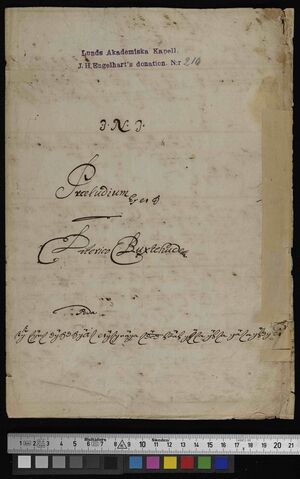S-L Engelhart 216: Difference between revisions
Fiskfan1999 (talk | contribs) finally fixed incipit |
Fiskfan1999 (talk | contribs) No edit summary |
||
| Line 7: | Line 7: | ||
The manuscript is written in [[New German Tablature Notation]]. It adheres to the older tradition in notating organ music in which the final note of each voice is written with a fermata (meaning to hold it to the end) instead of supplying the necessary number of ties and supplementary notes. It includes some ornaments (all are placed under the note it affects), one resembling a diagonal pound symbol, and another resembling a type of ''tremblement''. One unique feature that is found in this manuscript is that some small notes (pitch names) are written in-between other notes, some with and others without corresponding rhythmic symbols. | The manuscript is written in [[New German Tablature Notation]]. It adheres to the older tradition in notating organ music in which the final note of each voice is written with a fermata (meaning to hold it to the end) instead of supplying the necessary number of ties and supplementary notes. It includes some ornaments (all are placed under the note it affects), one resembling a diagonal pound symbol, and another resembling a type of ''tremblement''. One unique feature that is found in this manuscript is that some small notes (pitch names) are written in-between other notes, some with and others without corresponding rhythmic symbols. | ||
The hand is unidentified, but perhaps the manuscript was copied around 1710-1720 by [[Heinrich Christopher Engelhardt]] | The hand is unidentified, but perhaps the manuscript was copied around 1710-1720 by [[Heinrich Christopher Engelhardt]]. | ||
On the question of proximity to Buxtehude, it has been theorized that this is a copy of an autograph by Buxtehude (a "first-generation" copy, so to say). The features that support this theory include | On the question of proximity to Buxtehude, it has been theorized that this is a copy of an autograph by Buxtehude (a "first-generation" copy, so to say). The features that support this theory include | ||
| Line 16: | Line 16: | ||
== References == | == References == | ||
{{OnlFac|url=http://urn.kb.se/resolve?urn=urn:nbn:se:alvin:portal:record-321077|urlc=www.alvin-portal.org|date=20 July, 2023|sig=S-L Engelhart 216|imslp=854290}} | {{OnlFac|url=http://urn.kb.se/resolve?urn=urn:nbn:se:alvin:portal:record-321077|urlc=www.alvin-portal.org|date=20 July, 2023|sig=S-L Engelhart 216|imslp=854290}} | ||
[[Klaus Beckmann|Beckmann, Klaus]] (editor). ''Dietrich Buxtehude: Sämtliche Orgelwerke, Band I-II''. Wiesbaden, Breitkopf & Härtel, 1997. 106. | |||
[[Michael Belotti|Belotti, Michael]] (editor), ''Dietrich Buxtehude: The Collected works.'' Vol.15, "Orekydesm Toccatas, and Ciacconas for Organ (pedaliter) (Section B: Commentary)." New York: The Broude Trust, 1998. 6-7. | [[Michael Belotti|Belotti, Michael]] (editor), ''Dietrich Buxtehude: The Collected works.'' Vol.15, "Orekydesm Toccatas, and Ciacconas for Organ (pedaliter) (Section B: Commentary)." New York: The Broude Trust, 1998. 6-7. | ||
Revision as of 15:37, 2 January 2024

S-L Engelhart 216 is a manuscript which contains the Preludium in G Major by Dietrich Buxtehude and is held in the Universitetsbiblioteket, Lund.
Description
The manuscript is written in New German Tablature Notation. It adheres to the older tradition in notating organ music in which the final note of each voice is written with a fermata (meaning to hold it to the end) instead of supplying the necessary number of ties and supplementary notes. It includes some ornaments (all are placed under the note it affects), one resembling a diagonal pound symbol, and another resembling a type of tremblement. One unique feature that is found in this manuscript is that some small notes (pitch names) are written in-between other notes, some with and others without corresponding rhythmic symbols.
The hand is unidentified, but perhaps the manuscript was copied around 1710-1720 by Heinrich Christopher Engelhardt.
On the question of proximity to Buxtehude, it has been theorized that this is a copy of an autograph by Buxtehude (a "first-generation" copy, so to say). The features that support this theory include
- The inclusion of "I.N.I." on the title page,
- The writing of the name "Buxtehude" appearing to be in manu propria style,
- The similarity with some of the letters of tablature to those in known Buxtehude autographs.
References
S-L Engelhart 216 Online facsimile: www.alvin-portal.org accessed 20 July, 2023, mirrored IMSLP854290.
Beckmann, Klaus (editor). Dietrich Buxtehude: Sämtliche Orgelwerke, Band I-II. Wiesbaden, Breitkopf & Härtel, 1997. 106.
Belotti, Michael (editor), Dietrich Buxtehude: The Collected works. Vol.15, "Orekydesm Toccatas, and Ciacconas for Organ (pedaliter) (Section B: Commentary)." New York: The Broude Trust, 1998. 6-7.